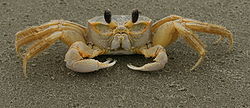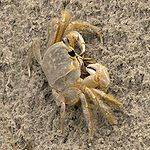Atlantic ghost crab
| Atlantic ghost crab |
|---|

|
| Scientific Classification |
|
| Binomial Name |
|
Ocypode quadrata |
The Atlantic Ghost Crab is a species of crab known by the scientific name Ocypode quadrata. The crabs in this genus are called ghost crabs because their matched the color of the sand, making them blend in and hard to spot. The name Ocypode means swift-footed. Their jointed legs help them move fast. This particular species, quadrata, has a square-like carapace, which undergoes a number of stages during metamorphosis. The Atlantic Ghost Crab is an unique crab because it tends to not go near the water like most crabs.
Body Design
The Atlantic Ghost Crab is a sandy-brown color with white claws. It blends in with its environment because of the similarity of the color of the sand and its body. The young crabs are usually darker than the adults. The crab consists of segmented body parts. The body can be broken into two main parts: the cephalothorax and the abdomen. The cephalothorax is the name given to the connected head and thorax. The quadratic carapace, a hard exoskeleton made from chitin, covers the cephalothorax and the majority of the abdomen. It grows to be two to three inches after the crab matures.[2] The males are usually larger than the females. This exoskeleton protects the crab from predators, prevents it from drying out, and supports the body. Also it has four pairs of walking legs used for locomotion. Because of its jointed legs, the Atlantic Ghost Crab is capable of moving in any direction. Another pair of legs, or claws, at the front are called chelipeds and are used for catching food. The males usually have a claw that is larger than the other.[3] If a claw were to break away, the crab could grow another one in its place. [4]
The crabs head slightly extends out of the carapace, revealing a small section called the rostrum.[5] It contains the stalks and antennae. The stalks are connected to the compound eyes, which can be turned 360 degrees.[2] The crabs are able to be aware and to prepare for predators with their great vision. Females are able to identify male crabs by the horns that are attached to the males’ eye. The antennae are sensory appendages. They are used to sense things in the environment. They breathe through gills. Unlike any other crab, the Atlantic ghost crab has air bags next to its gills. This enables it to store oxygen, which is needed when it buries itself for the winter. It can survive on this oxygen for six weeks.[3]
Life Cycle
Reproduction occurs sexually in this crab. The females can only reproduce after they shed their carapace,and their new exoskeleton has not hardened yet.[5] The males can sense when this happens by the biochemical signals that are given off by the females. Some scientists say that the tide plays a part in when this happens. The mating of the Atlantic Ghost Crab starts off as a competition between two males. They try to make themselves look tougher than the other by raising their claws. When one of the crabs backs off, the fight is over. The transfer of sperm happens in the burrows they make in the sand. The females store the fertilized eggs in their rounded abdominal flaps. Then the females lay their eggs in the water, where the larva hatch. [6]
The larva, also known as zoea, float freely around in the water. There are five different stages in the zoea stage.They are very small, and look like plankton. No resemblance of a crab is seen during this stage. It takes around ten moltings of the exoskeleton before they look like a crab. Then it is called a megalopa. This species has probably the biggest size of carapace during this stage. Then a full grown adult is created, which is usually two to three inches. The Atlantic Ghost Crab can live up to three years.[3]
Ecology
Warm sandy beaches are great places to spot Atlantic Ghost Crabs. Because of the sandy color of the crab, they often blend in with their surroundings. Atlantic Ghost Crabs have stopped residing on many beaches because of the disturbances. They prefer beaches where not a lot of human activity occurs. Currently they inhabit a variety of places along the Atlantic coast, ranging from Rhode Island to Brazil.[6] The crabs are most often found in coastal and tropical, or subtropical regions. Unlike most crabs, they try to remain on land as much as possible. They usually only go into the water to wet their gills and to lay their eggs. The burrows they dig keep them cool during the day, and they provide a shelter during the winter when they hibernate. These burrows can reach a depth of 4 feet. The younger crabs tend to make theirs closer to the water, while the adults try to stay farther away. They are usually 100 feet away from the ocean.[2]
During the night they emerge from their burrows to eat. The crab feeds on a number of things. They can be considered predators and scavengers. Clams, eggs, snails, and other small crabs are eaten by them. But the crab can also eat plants. They are generalists and opportunists. Any dead thing washed up to shore will be eaten by them. The Atlantic Ghost Crab takes advantage over everything on the beach they reside on. They avoid getting preyed on by not going out in daylight (they are nocturnal). Their greatest predator is the raccoon. Burrowing owls and gulls also feed on this crab.[6] [7]
Human Impact
Atlantic Ghost Crabs dwell on beaches,and human activity can often disturb the life of a crab. The number of crabs present on beaches that contain humans is far less than the population on beaches without human activity. People often do not realize the impact they have on the animals around them. While at the beach, they trample all over the sand. The force applied to the sand causes it to compress, which destroys some burrows. It draws out the moisture from the sand, which is needed for the crabs' gills to function. Also being careless with the vegetation impacts its ability to find food. Rebuilding beaches affect the population of the Atlantic Ghost Crab by causing erosion in the sand. Pollution greatly impacts them. Without a beach with clean water, the larval stage will not survive in the ocean. They need non-polluted water for their gills. Also they can choke on and get trapped in litter. Hurricanes and storms cause sand erosion.[6]
Atlantic Ghost Crabs are useful for research, education, and to keep as pets. Scientists often use the population of the Atlantic Ghost Crabs to measure the human impact on beaches. By counting the number of burrows, they can predict the number of crabs. They are able to identify if there is too much human activity, and the effect humans are having on the ecosystems. If desired people can keep them as pets. They can be used for breeding. Very careful and attentive care is necessary for them to live as pets.[6][3]
Video
Atlantic Ghost Crab
References
- ↑ Ocypode quadrata ITIS. Web. 02 December 2012 (Date-accessed).
- ↑ 2.0 2.1 2.2 Atlantic Ghost Crab Chesapeake Bay Program. Web. 03 December 2012 (Date-Accessed).
- ↑ 3.0 3.1 3.2 3.3 Ghost Crab (Sand Crab) Animal Spot. Web. 03 December 2012 (Date-Accessed).
- ↑ Crabs Think Quest. Web. 02 December 2012 (Date-Accessed).
- ↑ 5.0 5.1 CRABS, HORSHOE CRABS, HERMIT CRABS, COPEPODS AND SEA SPIDERS Facts and Details. Web. 04 December 2012 (Date-Accessed).
- ↑ 6.0 6.1 6.2 6.3 6.4 Simbeck, Rob For Wildlife Watchers: Atlantic ghost crab South Carolina Wildlife. Web. 04 December 2012 (Date-Accessed).
- ↑ Ocypode quadrata Atlantic Ghost Crab Encyclopedia of Life. Web. 11 December 2012 (Date-Accessed).



